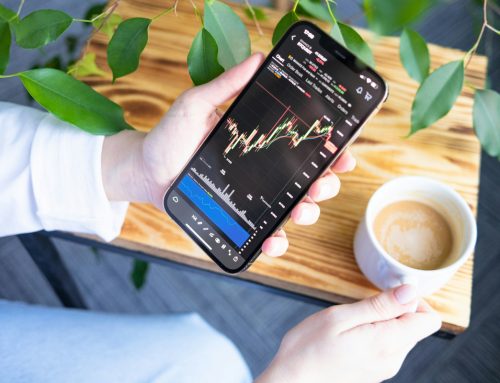Learning how to make money with options is a great stock investment strategy – but it can be a bit more complex than traditional stock trading. There are so many different ways you can leverage options, both as a seller and a buyer.
Today, we’ll look at two popular approaches to help you choose a path and narrow your focus: covered call vs long call. They involve the same type of option, but they’re very different.
A covered call involves owning a specific stock and then selling call options against that stock with the goal of earning premium without the holder of the contract exercising the option.
On the other hand, a long call involves purchasing a call option on the assumption that the stock in question is going to rise above the strike price before expiration.
In saying that, a covered call involves selling a contract, whereas a long call involves buying one. We’ll help you choose the right strategy below with a more detailed comparison of long call vs covered call options strategies.
But no matter which approach you take, set yourself up for success with VectorVest’s stock analysis software. It’s the best stock picker in the world, and when paired with the OptionsPro integration, will stack the deck in your favor as an options trader. Find out how today!
Overview of Call Options
Before we compare and contrast the covered call vs long call strategies, let’s take a step back and explain the difference between a call vs put and how stock options work in the first place.
These are financial derivatives that grant the holder the right, but not the obligation, to purchase a stock at a specified price (known as the strike price) within a certain period. Options contracts are typically sold in lots of 100 shares.
Every contract also has an expiration date. So, what happens when options expire? It depends on how the stock price acts relative to the strike price associated with the contract.
If the contract is in the money – meaning the stock price rises above the strike price – the holder can exercise the option to buy at the lower strike price, potentially securing a profit.
But if the stock price remains below the strike price, the investor would let the contract expire worthless. Their loss would be the premium they paid for the contract.
So, what are the benefits of trading stock options – specifically, call options? Here are 4 reasons these are a popular approach to options trading:
- Leverage: Call options allow investors to control a larger amount of the underlying asset for a relatively small investment, which can amplify returns.
- Limited Risk: The maximum loss is limited to the premium paid for the option, making it a controlled risk strategy. There is no unlimited downside risk for the holder of a call option.
- Flexibility: From hedging against potential losses in a stock portfolio to speculating on price movements, there are so many ways to use call options.
- Profit Potential: If the underlying asset’s price rises significantly, the return on investment can be substantial, given the leveraged nature of options.
We have a wealth of resources to help you learn options trading in our blog if you’re still in the early stages of this journey. But for now, let’s narrow our focus to the difference between a long call and covered call below.
What’s the Difference Between a Long Call and Covered Call?
One of the key benefits of options trading is the versatility it offers – which is why there are multiple ways you can make money with call options. So, what’s the difference between a covered call vs long call?
What is a Long Call?
As we briefly mentioned earlier, a long call is a bullish strategy where an investor buys a call option, betting that the underlying asset’s price will rise above the strike price before the option expires.
The primary goal is capital appreciation. The potential profit is theoretically unlimited as the asset’s price can continue to rise. All you need to pay is the premium for the contract, which can be very cheap, thereby giving you leverage.
In saying that, the risk is fairly low as well. You’re only risking the premium paid for the original contract if the stock’s price does not climb above the strike price. You’d simply let the contract expire worthless.
Say you have a bullish outlook on stock XYZ heading into the company’s earnings in a few months. The stock price sits at $40/share, and you suspect it could break through a previous resistance point of $50/share.
So, you buy a call contract for that stock with a strike price of your choosing – the more aggressive you are in your viewpoint, the less you’ll pay in premium. Let’s say you pick a strike price of $45 with an expiration date of 3 months.
Earnings come and your theory proves true – the stock skyrockets 25% to $50. You could then exercise your option to buy the stock at the strike price of $45 and then own it for cheaper or flip it for immediate profit.
Now, let’s look at the other half of the long call vs covered call comparison.
What is a Covered Call?
So, what is a covered call? In this situation, you’re actually acting as the seller of the options contract. It’s seen as a more conservative strategy than buying call options. You’d sell covered calls when you have a less bullish outlook or even a flat outlook on the stock in question.
You’d typically own the asset that you’re creating contracts for (otherwise, you’d be selling what is known as a “naked call” instead). This means your risk is inherently lower, and as long as the stock doesn’t fall in price, you end up earning income. It’s just a matter of how much income. Let’s look at the same example above, but this time, from the seller’s perspective.
You bought into stock XYZ at $40, but you suspect the earnings will not send shares skyrocketing. You sell a covered call with the same $45 strike price. Unfortunately, your theory proves wrong and the stock climbs to $50/share.
The investor you sold the call to exercises their right to buy the stock at $45/share, which means you still earn the $5/share profit from the sale – but you could have earned $10/share if you weren’t obligated to sell at that strike price!
Sure, the premium you earned from selling the contract in the first place will enhance your return, but there is still opportunity cost at play. This is why covered calls are bad in some cases.
As with any strategy, though, you can set yourself up for success with a more foolproof approach to stock analysis – like using our stock advisory paired with OptionsPro. More on that later.
We have more tips on how to sell options, specifically, selling covered calls. But if you’re still not sure this is the right approach for you, read on below as we compare and contrast covered call vs long call strategies side by side.
Covered Call vs Long Call: Which Strategy is Right For You?
Just as with decisions like trading futures vs options or even warrants vs options, there’s no right or wrong answer as to whether you should use a long call vs covered call strategy. It all comes down to your investment goals, risk tolerance, market outlook, and capital.
Investment Goals
If your primary objective is to generate consistent income and you already own shares of a stock, covered calls are typically the way to go. You can earn premiums on your existing holdings as an additional income stream. While the returns might be lower, it’s better than just owning a stock outright if the price is fairly stagnant.
On the other hand, those seeking high capital appreciation may be better suited to long calls. These give you the leverage to benefit from substantial price increases without needing to own the underlying stock. If you have a more bullish outlook on the asset in question and don’t mind taking on a bit more risk, this is the better play.
Risk Tolerance
Of course, the level of risk you’re willing to take on will play the biggest role in whether you align more with a covered call vs long call strategy.
Covered calls are generally considered less risky compared to long calls because they involve owning the underlying asset. The premium received from selling the call option provides a buffer against minor declines in the stock price. If the stock’s price rises and you have to sell it, you’ll still earn some additional income as well.
Conversely, long calls involve a higher risk, as the entire premium paid for the option could be lost if the stock price does not rise above the strike price. This strategy is more appropriate for investors with a higher risk tolerance.
It’s worth noting that you can make both long and covered calls work with your risk tolerance by skewing the strike price and expiration date in coordination with the implied volatility of the stock in question.
Want to take on less risk? Choose more conservative expiration dates and strike prices, just be aware you’ll pay more in premium when buying long calls, and earn less in premium when selling covered calls. Learn more about risk management options trading in our blog.
Market Outlook
Your perspective on the market will be another contributing factor to which strategy you choose. Covered calls are typically used in a neutral to slightly bullish market.
This is because, while you want the stock to remain stable or rise slightly to benefit from the premium, a massive price rally would cap your gains at the strike price. At that point, you’d be better off just holding the stock and selling it after it pumps.
In contrast, long calls are best suited for a strongly bullish market outlook. If you expect a significant upward movement in the stock price, long calls allow you to leverage your investment and potentially achieve high returns. The potential profit is theoretically unlimited.
Capital Requirements
Both options strategies are great for those with low capital. However, covered calls require you to own the underlying stock, which can be expensive if the stock is high-priced.
Long calls only require you to have enough premium to buy the contract in the first place – but you will need to come up with the capital to purchase 100 shares of the stock at the strike price if you choose to exercise the option.
No Matter Your Options Strategy VectorVest Can Help You Earn Higher Returns With Less Work and Stress!
We hope you have a more clear understanding of the difference between a covered call vs long call after this comparison. They both have their advantages, and there will be situations where one strategy will be more beneficial than the other.
But across all stock trading strategies, having the best stock analysis app is paramount to help you make calculated, emotionless decisions that maximize your returns while minimizing risk.
That’s where VectorVest comes in. It’s the #1 investment app for beginner traders and experts alike because it tells you what to buy, when to buy it, and when to sell it – all in 3 simple ratings. You’ll spend less time stuck to your screen and you’ll win more trades along the way.
This means you can effortlessly uncover the best stocks for covered calls 2024 – but you can also find the best blue chip dividend stocks, aggressive growth stocks, falling stocks to buy, current undervalued stocks, or anything in between.
The integration with OptionsPro is especially important, though. This intuitive screener helps you pinpoint the perfect window to sell contracts to earn higher premiums without taking on more risk.
The software puts a suite of tools in your hands that help you navigate options trading with more confidence. You can fine-tune the strike price in your favor and compare different expiration dates whether you’re acting as a buyer or seller of options contracts.
VectorVest is a powerful tool in your arsenal no matter how you want to trade options – or even if you’re trying to build a stock portfolio for retirement! Learn more about how it works with a free stock analysis today!
Bringing Our Long Call vs Covered Call Comparison to a Close
As you can see, both covered call vs long call strategies have their place – it all depends on your income goals, your risk tolerance, and your outlook on a given stock.
Long calls provide better upside, making them ideal for bullish investors looking to maximize returns. Covered calls, on the other hand, offer a more balanced approach with consistent income and reduced risk for conservative investors seeking stability.
No matter which you choose, setting yourself up for success with the right tools can make a powerful difference in how you find and execute opportunities.
Our blog has more resources like what does it mean to exercise stock options, how are options taxed, dividend vs growth stocks, the most volatile stocks today, swing stock screener, best macd settings, and more.
Otherwise, get set up with the best stock apps for iPhone or best stock apps for Android at VectorVest today and transform your approach to analysis for the better. Give yourself an unfair advantage in buying or selling options to earn more returns with less work and stress!







Leave A Comment